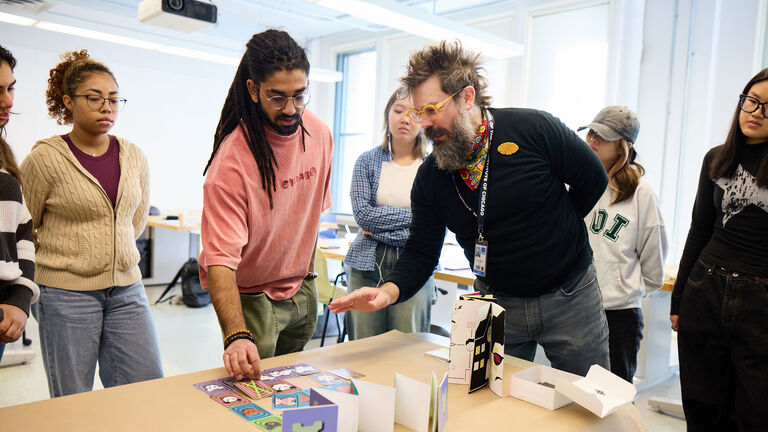
Tony Favarula
Undergraduate Overview
Visual Communication Design Undergraduate Overview
Spring 2026 Application Deadline: December 15
Fall 2026 Early Action & Priority Merit Scholarship Deadline: December 15
The Visual Communication Design department's undergraduate curriculum is structured to encourage the development of both generalized and specialized activities, as well as hybrids of both. Students acquire a thorough intellectual understanding of the implications, strategies, and roles of visual messages as well as the visual abilities necessary for conceptualization and creation and the technical tools and business skills required in professional practice.
Focus Areas
The major areas of focus are physical media (print, objects, and environments) and virtual media (interactive and time-based media) and include:
- Artists’ books
- Bookbinding
- Coding/programming/scripting
- Data visualization/diagrams/maps
- Design issues
- Digital/screen-based production
- Environmental/experience design
- Exhibitions/kiosks
- Identity/information systems
- Illustration/image making
- Installation/wayfinding
- Interface/interaction design
- Image/text narrative
- Letterpress printing
- Motion graphics/title design
- Packaging
- Posters
- Print production/digital and offset
- Publication/self-publishing
- Social design
- Strategy/methodology
- Sustainable design
- Symbols/icons/language
- Typography
- Visual/sequential narrative
- Website/cross-platform design
- Video
Portfolio Review
Students must pass a Visual Communication Design department portfolio review in order to enroll in intermediate courses in the department. The following Visual Communication Design courses are required in order to submit a portfolio to the department Portfolio Review.
- VCD 1001 Introduction to Visual Communication
- VCD 1002 Illustration Technologies Lab
- VCD 2011 Beginning Typography
- VCD 2012 Type Technologies Lab
- VCD 2001 Beginning Graphic Design
- VCD 2002 Image Studio
Visual Communication Design Undergraduate Curriculum [PDF]
AIGA
The department has an active AIGA (American Institute of Graphic Arts) student chapter. Led by a faculty member, the chapter holds regular meetings, hosts the department’s noon hour lectures in which professionals from the city and faculty from the department present their work, conducts tours of Chicago studios, holds an annual Town Hall AIGA event at the school, and oversees a biannual portfolio preparation seminar for all students preparing their work for submission to the department portfolio review.
Admissions Requirements and Curriculum
-
To apply to the School of the Art Institute of Chicago (SAIC), you must fill out an application and submit your transcripts, artist's statement, and letters of recommendation. And most importantly, we require a portfolio of your best and most recent work—work that will give us a sense of you, your interests, and your willingness to explore, experiment, and think beyond technical art, design, and writing skills.
To apply, please submit the following items:
Bachelor of Fine Arts in Studio Portfolio:
Submit 10–15 pieces of your best and most recent work. We will review your portfolio and application materials for merit scholarship once you have been admitted to SAIC.
When compiling a portfolio, you may concentrate your work in a single discipline or show work in a breadth of media. The portfolio may include drawings, prints, photographs, paintings, film, video, audio recordings, sculpture, ceramics, fashion designs, graphic design, furniture, objects, architectural designs, websites, video games, sketchbooks, scripts, storyboards, screenplays, zines, or any combination of the above.
Learn more about applying to SAIC's Bachelor of Fine Arts in Studio, or view our portfolio preparation guide for more information.
-
Studio 69 - CP 1010 Core Studio Practice I (3)
- CP 1011 Core Studio Practice II (3)
- CP 1020 Research Studio I (3)
- CP 1022 Research Studio II (3)
- SOPHSEM 2900 (3)
- PROFPRAC 39XX (3)
- CAPSTONE 49XX (3)
- Studio Electives (48)
Art History 15 - ARTHI 1001 World Cultures/Civilizations: Pre-History—19th Century Art and Architecture (3)
- Additional Art History Course at 1000-level (e.g., ARTHI 1002) (3)
- Art History Electives at 2000-, 3000-, or 4000-level (9)
Liberal Arts 30 - ENGLISH 1001 First Year Seminar I (3)
- ENGLISH 1005 First Year Seminar II (3)
- Natural Science (6)
- Social Science (6)
- Humanities (6)
- Liberal Arts Electives (6)
- Any of the above Liberal Arts or certain AAP or EIS
General Electives 6 - Studio, Art History, Liberal Arts, AAP, or EIS
Total Credit Hours 120 * BFA students must complete at least two classes designated as "off campus study." These classes can also fulfill any of the requirements listed above and be from any of the divisions (Art History, Studio, Liberal Arts, or General Electives).
Total credits required for minimum residency 66 Minimum Studio Credit 42
Course Listing
BFA in Studio with Thesis Option (Liberal Arts or Visual Critical Studies)
Students interested in pursuing the BFA in Studio with the Thesis Option (Liberal Arts or Visual Critical Studies) should contact their academic advisor for details about eligibility, program requirements, and the application process.
Take the Next Step
Visit the undergraduate admissions website or contact the undergraduate admissions office at 800.232.7242 or ugadmiss@saic.edu.
Upcoming Admissions Events
Meet with us, learn more about SAIC and our curriculum, and get feedback on your work. LEARN MORE.
Get More Info
Sign up for email updates to learn more about our undergraduate programs.